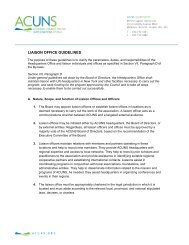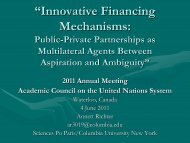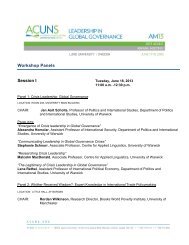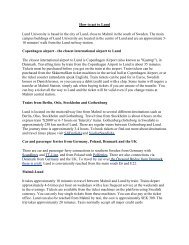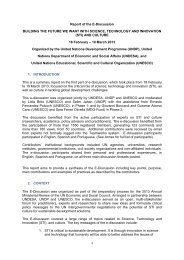THE FUTURE OF NUCLEAR ENERGY TO 2030 AND ITS ... - acuns
THE FUTURE OF NUCLEAR ENERGY TO 2030 AND ITS ... - acuns
THE FUTURE OF NUCLEAR ENERGY TO 2030 AND ITS ... - acuns
You also want an ePaper? Increase the reach of your titles
YUMPU automatically turns print PDFs into web optimized ePapers that Google loves.
The Centre for International Governance Innovation<br />
so potentially catastrophic that every means possible, including<br />
relatively carbon-free nuclear energy, should be<br />
deployed, regardless of cost. Yet it would take decades<br />
for nuclear to make significant inroads into carbon emissions<br />
even in the best of circumstances. Since resources<br />
for tackling climate change are not unlimited, choices<br />
must be made based on efficacy and cost, especially if<br />
government subsidies are being sought. According to research<br />
by Amory Lovins (see chart on page 17) , nuclear<br />
is more expensive than any technology except traditional<br />
gas-fired plants (operating at high gas prices) in terms<br />
of displaced carbon emissions from coal plants.<br />
The pricing of carbon through taxes and/or a cap-and–<br />
trade mechanism would improve the economics of<br />
new nuclear build compared with coal and gas, but it<br />
will also favour such alternatives as conservation, efficiency,<br />
carbon sequestration and renewables. As the<br />
December 2009 Copenhagen Climate Change Summit<br />
demonstrated, a global climate change regime that puts<br />
a predictable, stable price on carbon is years away, although<br />
governments and regions may implement their<br />
own mechanisms.<br />
Industrial Bottlenecks and<br />
Personnel Constraints<br />
Compounding the economic challenges of nuclear energy<br />
is a lack of industrial capacity and personnel constraints.<br />
The rate at which countries can ramp up a nuclear<br />
energy program will vary. The US has a particularly<br />
flexible economy that responds quickly to market opportunities,<br />
while semi-command economies, like those of<br />
China and Russia, may be able to direct resources where<br />
needed. In between these extremes lie other countries<br />
that will prove less nimble. Over the medium term, the<br />
industry itself will undoubtedly ramp up in response to<br />
clear demand. Yet it faces a classic investment catch-22:<br />
it will have to be convinced of the likelihood of a major<br />
revival before investing in the necessary specialized and<br />
expensive production capacity to make one possible.<br />
The other uncertainties surrounding the future of nuclear<br />
electricity make this a tricky balancing act.<br />
Nuclear Waste<br />
The final major constraint on a global expansion of nuclear<br />
energy is the abiding controversy over high-level nuclear<br />
waste disposal. The principal proposed long-term solution,<br />
which attracts close to scientific consensus, is deep geological<br />
burial. Almost six decades after commercial nuclear energy<br />
was first generated, not a single government has succeeded<br />
in opening such a repository for civilian high-level nuclear<br />
waste. Plans for a site at Yucca Mountain in Nevada have<br />
run aground due to persistent political opposition. Currently,<br />
only Finland and Sweden are well advanced and could<br />
have their repositories operating by 2020, followed by other<br />
European countries in the <strong>2030</strong>s and 2040s. For new entrants<br />
in the nuclear power business, with just one or two reactors,<br />
establishing their own nuclear waste repositories is likely to<br />
be prohibitive on grounds of cost and capacity.<br />
The lack of disposal options for waste that may last thousands<br />
of years could spur opposition to nuclear energy in<br />
new entrants, as it still does in some existing nuclear energy<br />
states. To deal with the waste problem, international cooperation<br />
will be necessary in the form of regional repositories<br />
or nuclear waste “take back” schemes. But there is great<br />
sensitivity in all countries, with the apparent exception of<br />
Russia, about becoming a nuclear waste dump. An evolving<br />
approach, pioneered by Canada and Sweden, is a comprehensive<br />
national consultation aimed at reaching consensus<br />
on a long-term nuclear waste management strategy.<br />
Canada’s three-year process of citizen engagement resulted<br />
in an agreed plan for “adaptive phased management” that<br />
could be a model for others.<br />
18 cigionline.org



